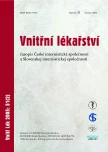Congenital adrenal hyperplasia, defect of 17α-hydroxylase as a rare cause of hypertension and hypocalaemia
Authors:
V. Olšovská 1; J. Šulcová 2; A. Hondlová 1; H. Šiprová 1
Authors‘ workplace:
II. interní klinika Lékařské fakulty MU a FN u sv. Anny, Brno, přednosta doc. MUDr. Miroslav Souček, CSc.
1; Oddělení steroidních hormonů Endokrinologického ústavu, Praha, ředitel doc. MUDr. Vojtěch Hainer, CSc.
2
Published in:
Vnitř Lék 2005; 51(2): 226-230
Category:
Case Reports
Overview
Authors describe infrequently occurring case of congenital adrenal hyperplasia, partial defect of 17α-hydroxylase in female patient with hypertension, hypocalaemia, menstrual cycle disorders and sterility. Diagnosis was established on the basis of native examination of steroid spectrum together with both stimulation and suppression tests and CT examination. After the treatment with dexamethason was established, the blood pressure and electrolyte levels reached the correction. This report supports the importance of the whole steroid spectrum examination in the patients with this symptomatology in order to eliminate rare causes of endocrine hypertension.
Key words:
congenital adrenal hyperplasia – endocrine hypertension – hypocalaemia – defect of 17α-hydroxylase
Sources
1. Hampl R, Stárka L. Současné možnosti steroidní laboratorní diagnostiky. DMEV 1999; 4: 206–211.
2. Šulcová J, Stárka L. Adrenální enzymopatie s pozdním nástupem. In: Stárka L et al. Aktuální endokrinologie. Praha: Maxdorf 1999: 540–562.
3. Procházková V, Lebl J et al. Klinická diagnostika pacientů s kongenitální adrenální hyperplazií. Česko–slovenská pediatrie 1999; 10: 544–547.
4. Costa-Santos M, Kater CE et al. Two prevalent CYP17 mutations and genotype-phenotype correlations in
24 Brazilian patients with 17-hydroxylase deficiency. Hum Genet 2004; 89: 95–96.
5. Van Den Akker EL, Koper JW et al. Differential inhibition of 17-hydroxylase an 17, 20-lyase activities by three movel missense CYP 17 mutations identified in patients with P450c17 deficiency. J Clin Endocrinol Metab 2002; 87. 5714–5719.
6. Biglieri EG, Herron MA et al. 17- hydroxylation deficiency in man. J Clin Invest 1966; 45: 1946–1954.
7. Imai T, Yanase T et al. Canadian Mennonites and individuals residing in the Friesland region of The Netherlands share the same molecular basis of 17-hydroxylase deficiency. Hum Genet 1992; 89: 95–96.
8. Costa-Santos M., Kater, CE et al. Two intronic mutations cause 17-hydroxylase deficiency by disrupting splice acceptor sites: direct demonstration of abberant splicing and absent enzyme activity by expression of the entire CYP17 gene in HEK–293 cells. J Clin Metab 2004, 89, 43–48.
9. Kater CE, Biglieri EG. Disorders of steroid 17-hydroxylase deficiency. Endocrin Metab Clin North Am 1994; 23: 341–357.
10. Grumbach MM, Hughes IA et al. Disorders of sex differentiation. In: Larsen PR, Kronnenberg HM et al. Wiliams textbook of endocrinology. 10th ed. Philadelphia: WB Saunders 2003; 842–1002.
11. Yanase T, Simpson ER et al. 17-hydroxylase/ 17,20 lyase deficiency: from clinical investigation to molecular definition. Endocrin Rev 1991; 12: 91–108.
12. Mendonca BB, Inacio M et al. Male pseudohermafroditism due to 17-betahydroxysteroid dehydrogenase 3 deficiency. Diagnosis, psychological evaluation and management. Medicine 2000; 79:
299–309.
13. Rabinovici J, Blankstein J et al. In vitro fertilization and primary embryonic cleabage beta estradiol, are possible in 17-hydroxylase deficiency despite extremely intrafollicular 17-beta estradiol. J Clin Metab 1989; 68: 693––697.
14. Votava F, Kračmar P et al. Novorozenecký screening kongenitální adrenální hyperplazie. Čes Slov pediatrie 2002; 12: 690–696.
15. Lisá L. Nové poznatky o léčbě vrozené adrenální hyperplazie. Forum medicinae 2000; 2: 52–57.
16. Ferrari P, Bianchetti M. Juvenile hypertension, the role of genetically altered steroid metabolism. Hormone research 2001; 5: 213–223.
17. Widimský J. Hypertenze. Praha: Triton 2002: 368–370.
Labels
Diabetology Endocrinology Internal medicineArticle was published in
Internal Medicine

2005 Issue 2
Most read in this issue
- Pulse pressure in the young population detected by ABPM and it’s relation to metabolic and anthropometric parameters
- Tumor lysis syndrome
- Congenital adrenal hyperplasia, defect of 17α-hydroxylase as a rare cause of hypertension and hypocalaemia
- Personal experience with the origin and duration of spontaneous remission in adult type 1 diabetics
